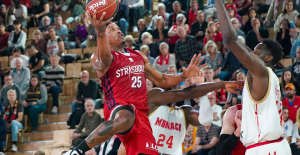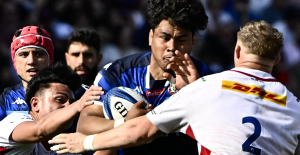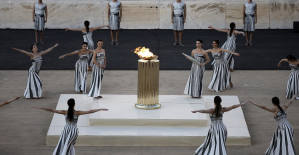The sun has just set, twilight is gradually giving way to darkness over the suburb of Berlin. It was just after 8 p.m. on April 14, 1943, a Wednesday, when a prisoner and an SS man exchanged words in “Sonderlager A” at the head of the Sachsenhausen concentration camp in Oranienburg. Seconds later the concentration camp prisoner is hanging dead in the barbed wire fence; there's a bullet in his head.
The 36-year-old was just one of more than 30,000 victims of the concentration camp north of the Reich capital; death was common here. Nevertheless, this case is special. Because not only did federal German prosecutors investigate this particular course of events in detail in order to prepare an indictment. Even the SS itself had sent high-ranking investigators on April 15, 1943 to secure clues and question witnesses: more than unusual in a place of permanent voluntary death like Sachsenhausen.
This was due to the person whose life had ended violently: Yakov Dzhugashvili, born in 1907, was the eldest son of Josef Dzhugashvili, better known by his nickname "Stalin", the ruler of the Soviet Union. Because of his father, the artillery lieutenant who was captured near Vitebsk on July 16, 1941 was not starved like many other Red Army soldiers or murdered in a mass shooting. Rather, he sat with four British prisoners in a special area on the outskirts of Sachsenhausen concentration camp - intended as a bargaining chip. Unlike the prisoners in the main camp, his life should be protected at all costs.
25 years later, Stalin's son was a topic again, this time he was featured in the world press on the occasion of the memoirs of Stalin's daughter Svetlana Alliluyeva that had just been published. For example, the magazine “Der Spiegel” reported: “The only thing that is certain is that Stalin’s son lived from October 1941 to August 1943 in the officers’ camp (‘Oflag’) XIII D in Hammelburg (Lower Franconia) and then until autumn 1944 in Oflag XC in Lübeck-Vorwerk Confused speculation followed as to whether he had committed suicide in 1945 before the liberation by the Red Army, died in a military hospital or drowned in exile in Argentina, or whether he was still alive "hidden somewhere in Europe".
Quickly busybodies spoke up. A former concentration camp guard announced in an article in the "Bild am Sonntag" (appears like WELT AM SONNTAG in the Axel Springer publishing house) that he knew the truth: his superior, the concentration camp torturer in Sachsenhausen, Kurt Eccarius, had Stalin's son at the beginning of April Murdered with pistol shots in the courtyard of the concentration camp prison in 1944.
That was reason enough for the Munich II public prosecutor's office to expand ongoing investigations against Eccarius in the fall of 1967 to include the suspicion of the murder of Yakov Dschugashvili. But even after the first interrogations, it became clear that this statement could not be true. WELT AM SONNTAG has the corresponding file with 209 pages.
According to her, the breakthrough for the investigation came in mid-February 1968. The US State Department published 14 pages of documents and ten photos from April 1943 - a report that two investigators from the criminal police department of the Reich Security Main Office (RSHA) based on witness statements after the death of Dschugashvili had put together. SS chief Heinrich Himmler then sent it to Hitler's foreign minister; the cover letter, kept in a familiar tone, began with the salutation "Dear Ribbentrop". Anglo-American specialists found the material on June 12, 1945 in a file cache in Thuringia.
For several weeks, Western diplomats considered making the report available to their (still) ally Stalin as a gesture of goodwill; but then they decided against it because the evidence of his son's death could have weighed on the talks at the Potsdam Conference. Only a microfilm backup copy survived, lying forgotten in the State Department's warehouse in Washington until the matter became topical in 1967 with the memoirs of Stalin's daughter.
The report also gave the names of several SS guards on duty on April 14, 1943 in the Sachsenhausen special camp. Now the Munich prosecutors could really get started. They determined their whereabouts and questioned them. Because, according to the RSHA report, a certain Konrad Harfich shot Stalin's son in the head, they opened a murder investigation against the now 66-year-old pensioner. An important witness was his former superior, Karl Jüngling, who, as an SS man with the rank of non-commissioned officer, was responsible for “Sonderlager A” on the outskirts of the concentration camp.
Neither Harfich nor the young man could be taken into custody – none of the legal reasons existed: no risk of repetition, no risk of collusion (the evidence existed), and no risk of absconding, because by the end of the 1960s, German courts had long since had concentration camp perpetrators with far more serious charges Leave freedom awaiting trial, if there was any indictment at all. The files of the public prosecutor's office, which can now be viewed without any problems in the Munich State Archives, show the conscientiousness of the criminal prosecutors - and at the same time exemplify the reasons for the extensive failure of the legal investigation of Nazi crimes.
Further research and hearings of witnesses began. The RSHA investigator who was sent to "Sonderlager A" in 1943 spoke out, as did Jüngling and Harfich, as well as several other SS men. In order to get statements from the four British fellow prisoners, the Munich public prosecutor's office contacted the German embassy in London; however, one of the four could not be located because of his commonplace name, two others had already died. The last, however, testified at length before a diplomat. The statements of former prisoners suggested that Harfich, before or after his function at "Sonderlager A", was also used as a guard at one of the worst work details at Sachsenhausen concentration camp, the clinker factory. Therefore, an additional investigation was initiated against him.
The more information prosecutors gathered, the clearer it became as to what actually happened on April 14, 1943. A few weeks earlier, probably in early February 1943, the SS had brought Yakov Dschugashvili to the newly established "Sonderlager A" after he had previously been imprisoned in various camps for officers who were prisoners of war and possibly in the camp prison of Sachsenhausen. Besides him, the nephew of Soviet Foreign Minister Vyacheslav Molotov, who was also captured as an officer in the Red Army, and four Britons were sitting here.
One of them, a sergeant named Thomas Cushing, occasionally spoke to Dzhugashvili, who introduced himself as "Stalin's son." Dzhugashvili spent the day in forced idleness. At times, the Briton tried to improvise mutual language lessons with him, but soon gave up. In the second week of April, tensions increased in "Sonderlager A". Stalin's son accused Molotov's nephew of being a spy for the camp Gestapo and perhaps of using a false identity; the two are said to have even fought.
On the evening of April 14, 1943, shortly before the privileged prisoners were locked in their barracks as usual, Dschugashvili demanded that Karl Jüngling be taken immediately to the concentration camp commandant, Anton Kaindl. Such a request was, with all the privileges of the inmates of "special camp A", then too much. Jüngling replied that Dschugashvili should make a "written submission". This annoyed Stalin's son; according to Cushing, Jüngling and Harfich, he continued to insist on a conversation with Kaindl and, according to Cushing, yelled in broken German: "Be a man and shoot me!"
Then Dschugashvili stepped over the two low tripwires in front of the high-voltage fence. At that moment, Harfich shot his head and hit him in the skull, "about four centimeters from the right ear, just below the right cheekbone," according to the brief examination report by the SS doctor from Sachsenhausen.
Whether Stalin's son was already reaching for the electrified fence at that moment or whether he fell forward from the impulse of the hit from a distance of less than ten meters could not be clarified with the few traces secured at the time. In any case, as the photos of the RSHA investigators show, Yakov's right hand touched the high-voltage wire. The photos, preserved only as microfilm copies, are of too poor quality to confirm Cushing's statement that Dzhugashvili's face was badly burned.
In view of this situation and the constitutional principle in dubio pro reo, the Munich public prosecutor's office had to drop the criminal proceedings against Harfich. Because there was not enough evidence that the headshot was really fatal. In addition, Stalin's son repeatedly demanded, independently documented, that the SS man should shoot him. In favor of the accused, it had to be assumed that Yakov Dschugashvili committed suicide at the hands of others, better known by the English term suicide by cop. So Harfich remained unpunished despite the admitted and in any case fatal headshot. The principles of the rule of law prevented trial and judgment, as they did with thousands of other SS perpetrators and other war criminals.
You can also find "World History" on Facebook. We are happy about a like.

 War in Ukraine: when kyiv attacks Russia with inflatable balloons loaded with explosives
War in Ukraine: when kyiv attacks Russia with inflatable balloons loaded with explosives United States: divided on the question of presidential immunity, the Supreme Court offers respite to Trump
United States: divided on the question of presidential immunity, the Supreme Court offers respite to Trump Maurizio Molinari: “the Scurati affair, a European injury”
Maurizio Molinari: “the Scurati affair, a European injury” Hamas-Israel war: US begins construction of pier in Gaza
Hamas-Israel war: US begins construction of pier in Gaza First three cases of “native” cholera confirmed in Mayotte
First three cases of “native” cholera confirmed in Mayotte Meningitis: compulsory vaccination for babies will be extended in 2025
Meningitis: compulsory vaccination for babies will be extended in 2025 Spain is the country in the European Union with the most overqualified workers for their jobs
Spain is the country in the European Union with the most overqualified workers for their jobs Parvovirus alert, the “fifth disease” of children which has already caused the death of five babies in 2024
Parvovirus alert, the “fifth disease” of children which has already caused the death of five babies in 2024 Inflation rebounds in March in the United States, a few days before the Fed meeting
Inflation rebounds in March in the United States, a few days before the Fed meeting Video games: Blizzard cancels Blizzcon 2024, its annual high mass
Video games: Blizzard cancels Blizzcon 2024, its annual high mass Falling wings of the Moulin Rouge: who will pay for the repairs?
Falling wings of the Moulin Rouge: who will pay for the repairs? “You don’t sell a company like that”: Roland Lescure “annoyed” by the prospect of a sale of Biogaran
“You don’t sell a company like that”: Roland Lescure “annoyed” by the prospect of a sale of Biogaran Exhibition: in Deauville, Zao Wou-Ki, beauty in all things
Exhibition: in Deauville, Zao Wou-Ki, beauty in all things Dak’art, the most important biennial of African art, postponed due to lack of funding
Dak’art, the most important biennial of African art, postponed due to lack of funding In Deadpool and Wolverine, Ryan and Hugh Jackman explore the depths of the Marvel multiverse
In Deadpool and Wolverine, Ryan and Hugh Jackman explore the depths of the Marvel multiverse Tom Cruise returns to Paris for the filming of Mission Impossible 8
Tom Cruise returns to Paris for the filming of Mission Impossible 8 Skoda Kodiaq 2024: a 'beast' plug-in hybrid SUV
Skoda Kodiaq 2024: a 'beast' plug-in hybrid SUV Tesla launches a new Model Y with 600 km of autonomy at a "more accessible price"
Tesla launches a new Model Y with 600 km of autonomy at a "more accessible price" The 10 best-selling cars in March 2024 in Spain: sales fall due to Easter
The 10 best-selling cars in March 2024 in Spain: sales fall due to Easter A private jet company buys more than 100 flying cars
A private jet company buys more than 100 flying cars This is how housing prices have changed in Spain in the last decade
This is how housing prices have changed in Spain in the last decade The home mortgage firm drops 10% in January and interest soars to 3.46%
The home mortgage firm drops 10% in January and interest soars to 3.46% The jewel of the Rocío de Nagüeles urbanization: a dream villa in Marbella
The jewel of the Rocío de Nagüeles urbanization: a dream villa in Marbella Rental prices grow by 7.3% in February: where does it go up and where does it go down?
Rental prices grow by 7.3% in February: where does it go up and where does it go down? Even on a mission for NATO, the Charles-de-Gaulle remains under French control, Lecornu responds to Mélenchon
Even on a mission for NATO, the Charles-de-Gaulle remains under French control, Lecornu responds to Mélenchon “Deadly Europe”, “economic decline”, immigration… What to remember from Emmanuel Macron’s speech at the Sorbonne
“Deadly Europe”, “economic decline”, immigration… What to remember from Emmanuel Macron’s speech at the Sorbonne Sale of Biogaran: The Republicans write to Emmanuel Macron
Sale of Biogaran: The Republicans write to Emmanuel Macron Europeans: “All those who claim that we don’t need Europe are liars”, criticizes Bayrou
Europeans: “All those who claim that we don’t need Europe are liars”, criticizes Bayrou These French cities that will boycott the World Cup in Qatar
These French cities that will boycott the World Cup in Qatar Basketball: Strasbourg appeals the victory recovered by Monaco
Basketball: Strasbourg appeals the victory recovered by Monaco Top 14: UBB with Tatafu and Moefana against Bayonne
Top 14: UBB with Tatafu and Moefana against Bayonne MotoGP: Bagnaia dominates qualifying practice in Spain and sets track record
MotoGP: Bagnaia dominates qualifying practice in Spain and sets track record Olympic Games: in Athens, Greece transmits the Olympic flame to France
Olympic Games: in Athens, Greece transmits the Olympic flame to France


















